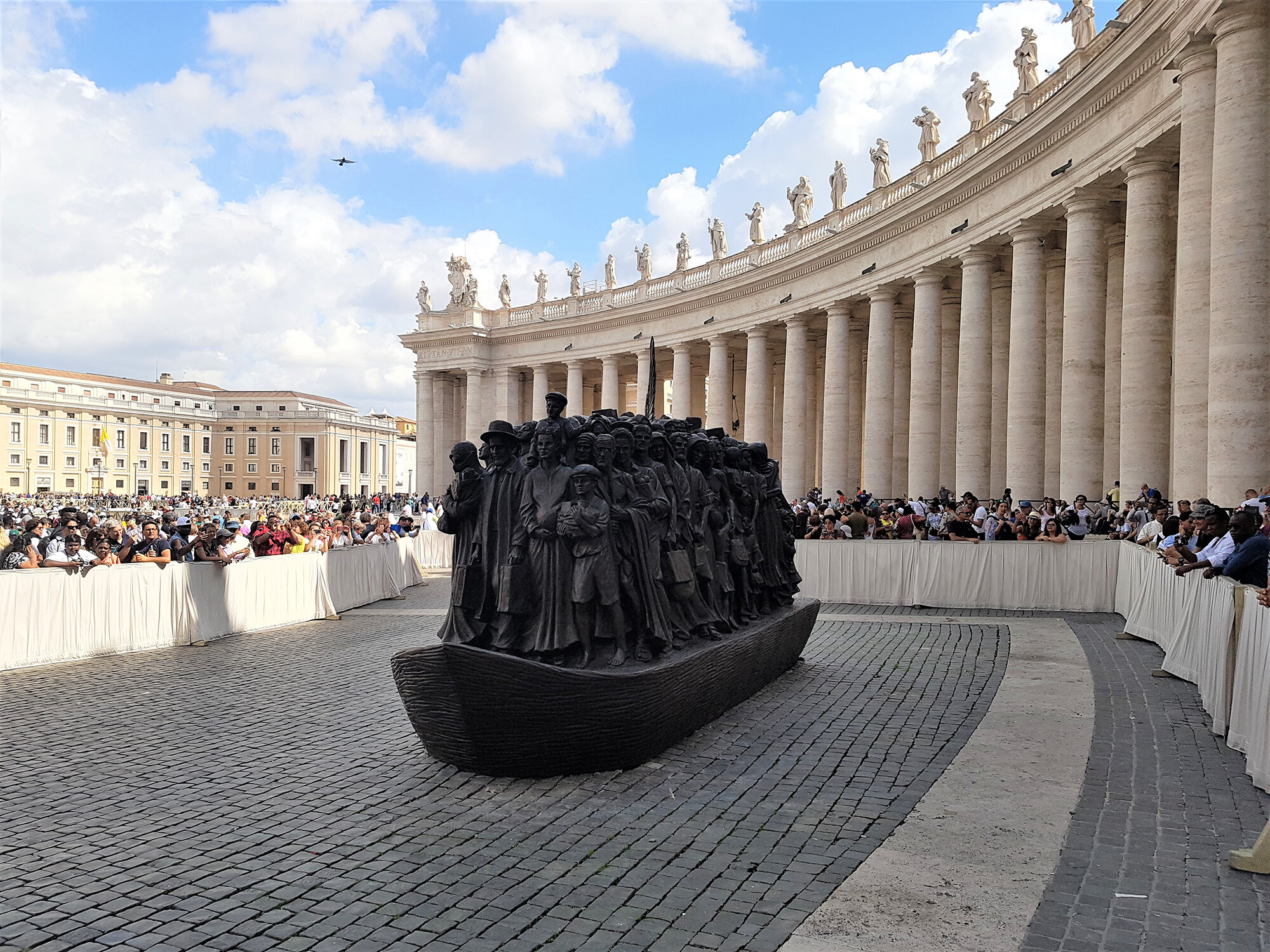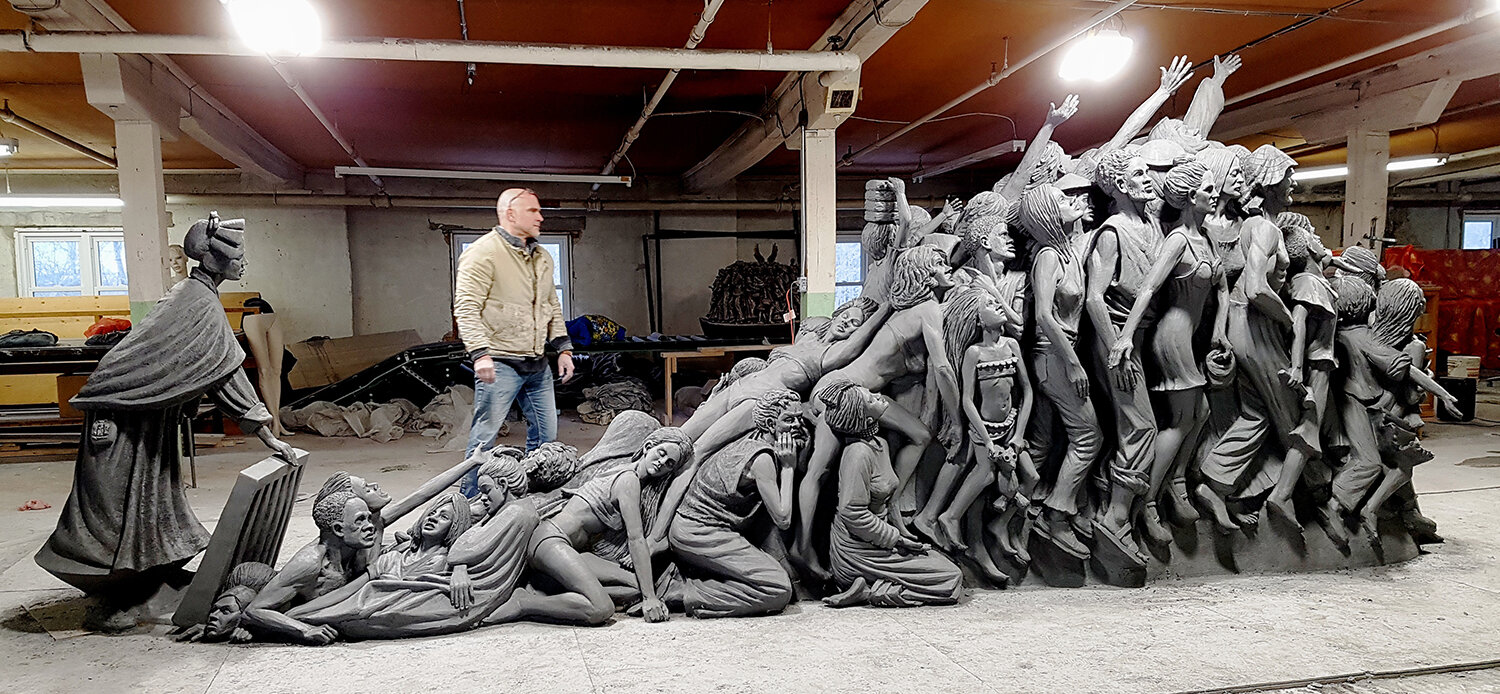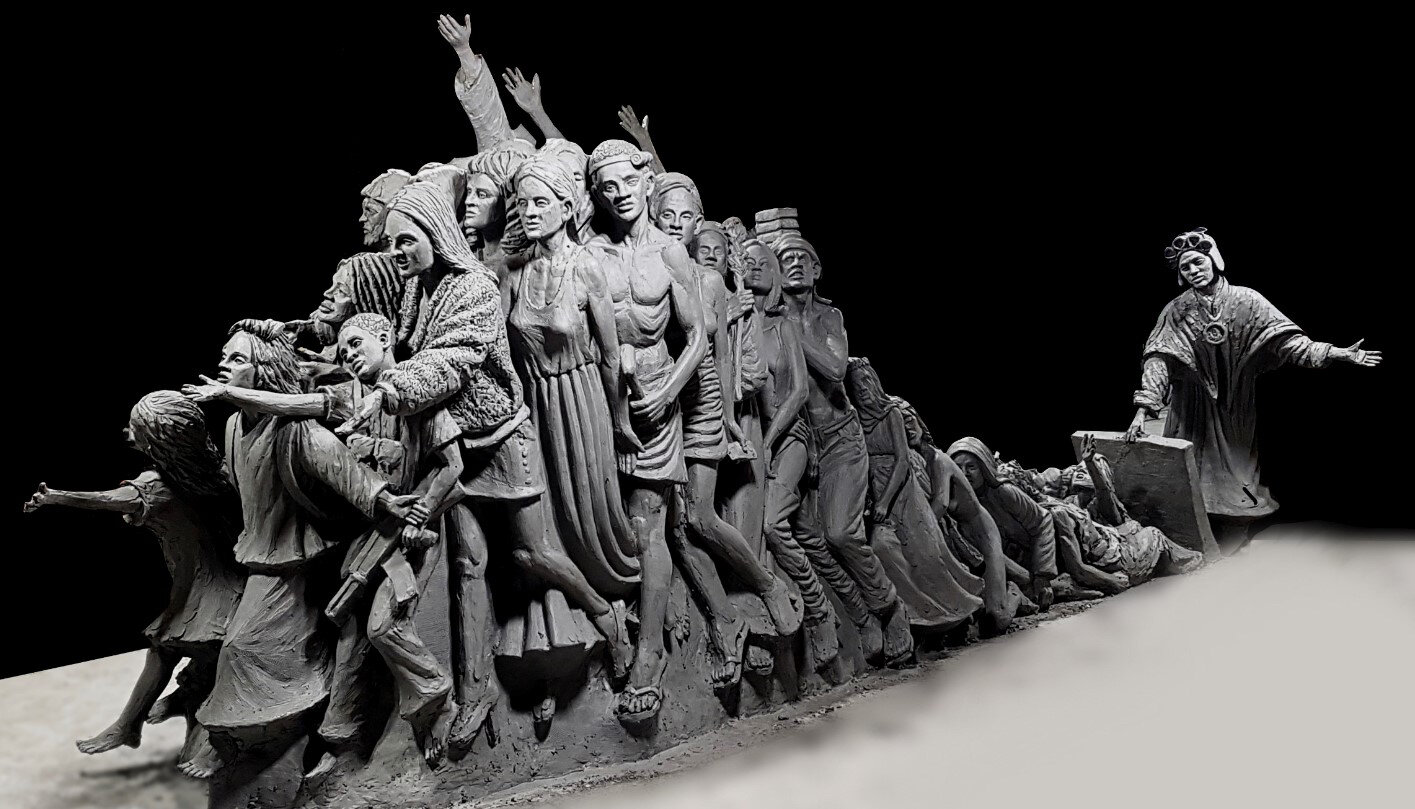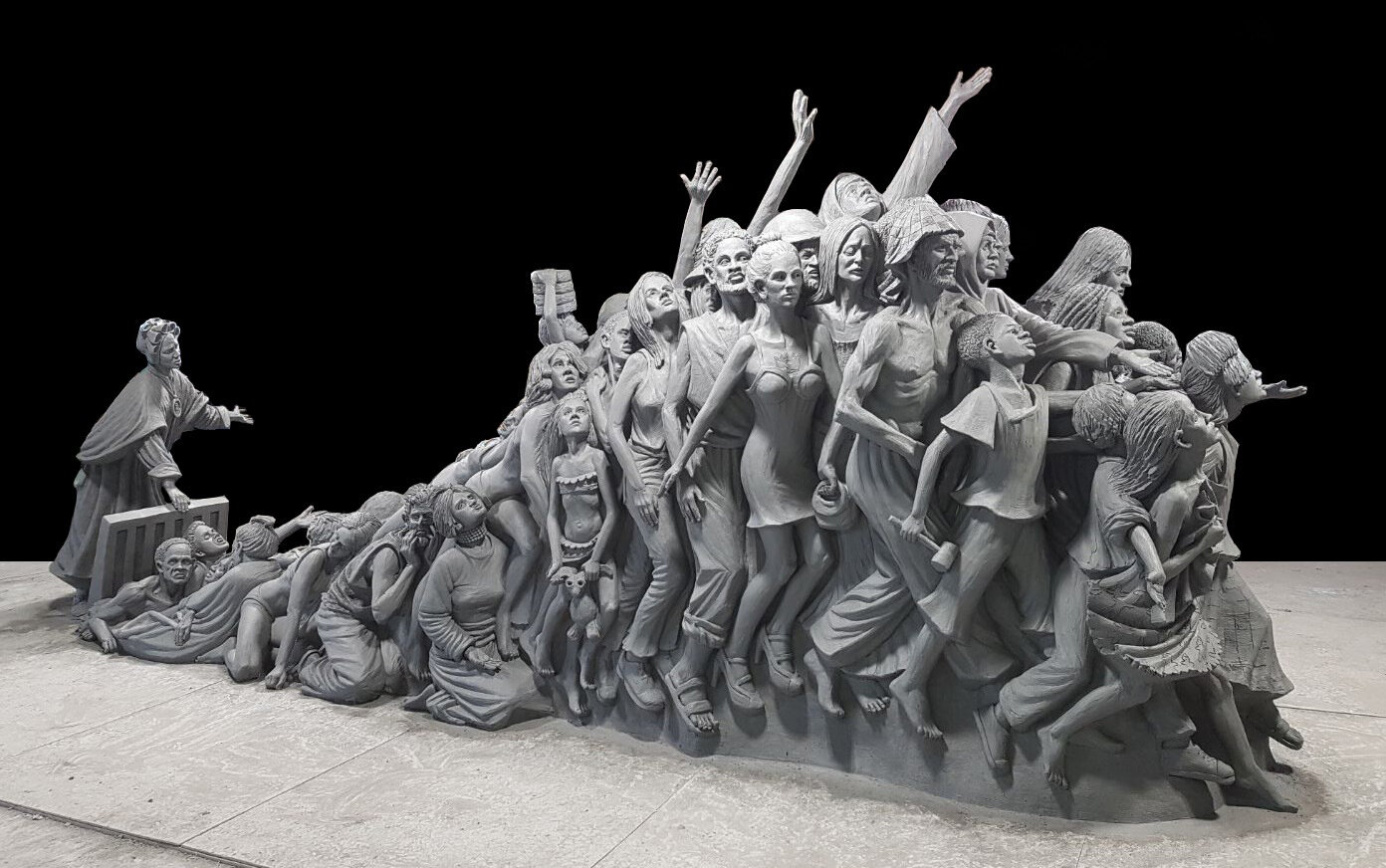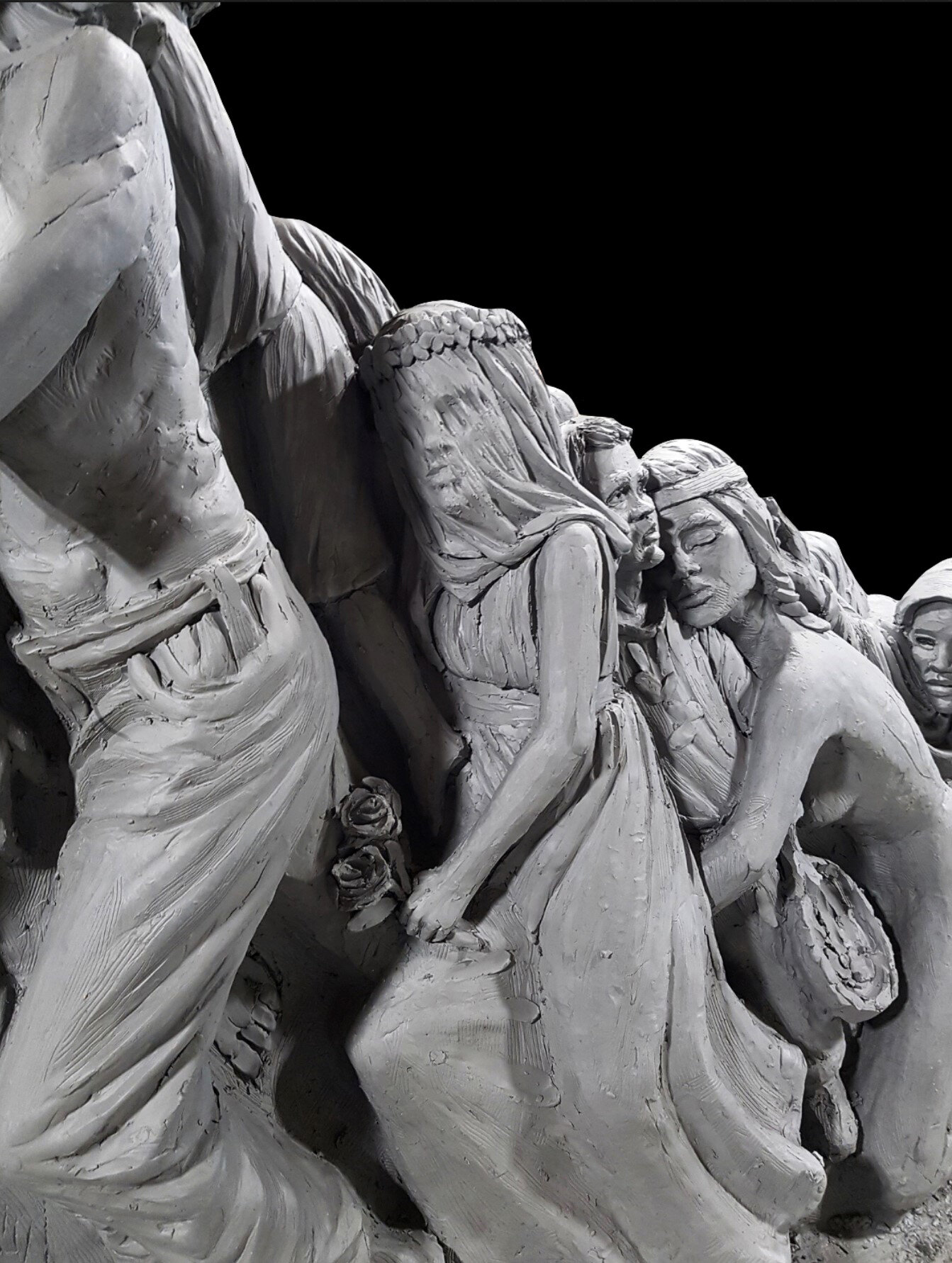“Essential Things:” An Interview with Tim Schmalz
Editor’s Note: Visual artist Tim Schmalz is most recently the sculptor of “Angels Unawares,” a sculpture on migration which has appeared in St. Peter’s Square at the Vatican; “Let The Oppressed Go Free,” a Vatican commission on human trafficking; and a series of Dante sculpture gardens. For the 700th anniversary of the death of Dante Alighieri, Schmalz has created a bronze relief sculpture series illustrating all 100 cantos of the Divine Comedy, casts of which will be installed in sculpture gardens in Italy and other locations around the world. His “Homeless Jesus” has appeared in front of the Papal Charities Building in Vatican City as part of its worldwide tour. Our conversation of March 18, 2021 has been lightly edited for length, topical organization, and clarity.
KC: Tim, thank you so much for taking the time to talk. Could you start by telling me what you’ve been working on?
TS: Oh wow, I’m done sculpting for a bit today, so now is a good time. I started working at five o’clock this morning and finished the last of my Dante pieces—well, the last for now. If all goes according to plan, I’ll be finishing the last two on September 14 in the Badia Fiorentina chapel in Florence.—By the way, you know Rodin’s “The Thinker”?
KC: I love it: I had the good fortune to see a cast of it in Philadelphia at the Rodin Museum when I was a teenager.
TS: But not a lot of people know it was originally called “The Poet.” It was intended to be a representation of Dante and to be installed in Rodin’s “Gates of Hell” series, his interpretation of Dante’s Inferno, which he never fully realized in his lifetime. But when my mom, a wonderful person, gave me a small replica of “The Thinker” when I was seventeen, I learned this, and I began to think that someone should sculpt not only the Inferno but the entirety of the epic, the Paradiso and Purgatorio included. When you think about it, too much emphasis on the Inferno was not the intention of Dante: the Divine Comedy is a comedy, and the Inferno is only one-third of the poem. So what I just completed today was every single canto of the Comedy, except for two: in Florence I am going to be completing the last canto of the Paradiso and also canto 14 of the Paradiso, which is when Dante sees Christ on his Cross.
[The whole process] was one of the most amazing sculptural experiences I’ve had in a long time. It took me more than a year; I actually started two years ago. When Covid came and I couldn’t travel, I thought it was time to finish. Usually I have a studio in Asia, I’m traveling there and going to meetings and speaking about Christian art, and then suddenly every day I was in one place, sculpting Dante… I thought, maybe the pandemic will make it possible for me to focus and really finish it. And then I thought, oh: if Dante was never in exile, maybe he would never have been able to finish this masterpiece. That dysfunction in his life created one of the greatest works of literature, of artwork, that we have. You can see how, in the Divine Comedy, he commiserates about how forlorn he is that he’s out of Florence: but it’s really a blessing in disguise. Pope Francis said that you’ll come out of this pandemic better or worse. I think that’s true. If we can be hopeful and use our creativity during this period, you never know. The Divine Comedy itself happened because of a disruption. So as we move forward, let’s cherish what may seem like interruptions.
What I wanted to do was to create [an image for] every single canto and in this way create an entranceway to Dante, who in turn is kind of an entranceway to spirituality. How many people over the years have held Dante as not only a tutor—a guide through heaven, hell, and purgatory—but almost a leader, or the person who introduces deeper spiritual ideas? I think the reason Dante is so wonderful at (leading people to consider spirituality) is that he’s so sculptural. That is, the imagery is so phenomenal. He lures you in—I think everyone can identify with the pain, misery, and suffering of the Inferno: so the starting point is somewhere we can all identify with. And then he brings you into paradise. It’s an amazing journey, and I think: why hasn’t anyone sculpted every single canto of the Divine Comedy? Well, partly because it’s a huge amount of work. (laughs) And now, after a year, I’m finished.
Anyway, I think Dante is meant to be experienced outside—you know, “midway through the course of life, I found myself in a dark forest…” so that it’s a journey. Instead of sitting in a library or a parlor, you can experience this work outside and, with Dante, move from hell to purgatory to heaven. I think it’s really cool that it’s tactile, too: an experience unlike most of the Dante-themed art out there. I think ninety-five percent of it is painting and drawing, which you cannot touch, and which you have to experience by going inside a museum or a church or by looking at a book. I hope to do one garden in the UK, one in America, and I’ve already confirmed the site for the Canadian, St. Michael’s College in Toronto. It’s the oldest Catholic university in Canada, founded prior to 1850 …. At the beginning Dante was taught there, and so it’s very appropriate to have this there now.
It would have been so difficult to do a project like this back then, though. For artists in the past, there was a very rigid definition of what art meant. Even a century ago, it would almost have been impenetrable to do such a massive body of work, when the only way they could interpret sculpture was in a very rigid, detailed way. I threw that out the window. I decided I was not going to concern myself, as Rodin said, with ringlets of hair, but to concern myself with essential things. I love that idea …
So I would read a canto every night and cross-reference how other painters and sculptors referenced that particular canto, and then the next day I’d create it. I wanted to do it in a way where, if you had never heard of Dante before, you would not only learn about it, but you would want to read the book. I thought that if, in 2021, I could get more people reading Dante, the sculpture would a success.
For the 600th anniversary [of Dante’s death] in 1921 in Manhattan, they created a Dante park—a lot different than mine, but there is actually a small park in Manhattan with a portrait of Dante. As people passed by, I was pointing to the statue and asking, “who is this?”, and no one knew who it was. That made me realize it wouldn’t be enough to put up a likeness: to capture his nose, his chin. I wanted to capture his ideas. That’s why my park begins with a portrait of Dante writing the first canto, and then the ninety-nine follow. … When you’re dealing with ideas like heaven, the deep ideas addressed in the Divine Comedy, the sculpture becomes an analogue.
There’s been very little representation of Dante in the last 100 years, and people fall into trying to have Dante and Beatrice talking: if I had a camera and I took a picture, this is what it would look like. Well, we have cameras now, but the last thing I would want to do would be to sculpt Dante’s nose 100 times. So I [dispensed with] the requirement for Dante to be in each scene. In the Purgatorio and Paradiso, it’s easier to get into what they’re talking about, into the ideas.
There’s been so much negativity going on over this past year, and Dante to me is an oasis. Even when traversing the Inferno, there is such peace that comes with the Divine Comedy, because there is structure. We’re living in this world of relativism and nihilism, but Dante’s world is very clean-cut. Everything has its place, and the order is just awesome. To visit this world every day, to see how he describes the structure, the order… it’s just so hopeful, so optimistic. It’s a breath of fresh air, breathed 700 years ago into this world. We can still learn so much from Dante’s world and from his brain. It’s still relevant today, in a world that has so much irrelevance in it.
KC: Can you tell me a bit about your early education and formation? How did you make the decision to pursue sculpting professionally?
TS: I was sixteen when I first created a sculpture that I just fell in love with. I had this absolute love for sculpture. I loved drawing, paint, all of that—I was an artistic child—but with sculpture, I thought, oh, this is just very exciting. So I kept on sculpting. During high school, I was into various artwork, and then I was accepted into the most respected art school in Canada, Ontario College of Arts. I only stayed there three months. I was disillusioned by the approach taken: more theory and abstraction. As a teenager, I thought I wanted to sculpt representationally. I was surrounded with a bunch of abstract work, and I began to question it. I did do some really conceptual work when I was a teenager and then began to think it wasn’t really worth the energy. A lot of it was just visual puns. A necessary condition [for a piece to be accepted] was that it was new or shocking. So I started to experiment with innovation or shocking pieces. The one piece that becomes almost symbolic to me is when I took a Pollock and projected it onto a screen and made a Jackson Pollock paint-by-number. I traced every contour and included a paint box…. And then the teacher held up an art magazine from the 1960s, showing me that Andy Warhol had done this—it had been done before! And because it was done before, it was worthless, it was junk. The only thing it was worth was the stretched canvas, which I thought about how to salvage—and so I thought: well, this is like some twisted childhood game, where the first to hit the buzzer wins and everyone else loses.
Then I thought about what I loved—Rodin, Michelangelo, for instance—and I thought, hmm, there’s something about the subject matter they’re doing: and I quit the college and started going to my own studio. At that point I embraced the idea of doing Christian artwork, and I thought: am I going to be my own teacher? No, the real masters are going to be my teachers. That’s when I consider myself as having had an artistic conversion: living in downtown Toronto, rejecting what all my peers were doing, trying out a sculpture of the Crucifixion instead. I didn’t care if it was new at all. I cared if it was good and if it meant something. I started thinking of art as functional. I would read up on, say, Catherine of Siena to give as true and authentic a representation as possible; I became very much interested in theology and reading the lives of the saints. It enhanced my artwork at the start. And even though I was a baptized Catholic and had an amazing conversion experience when I was seventeen, it wasn’t until I was around twenty that I had that artistic conversion. It was so absolutely rewarding. I was living in a small studio and sleeping on a board and keeping my clothes in a plastic bag, I had sporadic heat, and I was happy as I could possibly be. It was a joy to wake up and do a sculpture of a new saint. And now, thirty years later, I’m doing a sculpture on the theme of Hebrews 13:2, one of Padre Pio, an eleven-foot sculpture of Moses. …
The fabulous thing about Christianity is that it’s an unfading well of expression and truth. The art of the West, up until the past century, is ninety-nine percent Christian, and a lot of people try to skim over this fact. But to have a great sculpture, you need a great subject to begin with. An epic subject matter will lead to an epic piece of art. It’s almost not about skill, it’s not about design, it’s about the interior truth that the art piece is trying to bring out. And I thought about trying to become as invisible as possible, where the subject matter is not obscured or shadowed by my skill. … I remember, once when I was twenty, I had a dream and I tried to sculpt it and then I thought: Wait, what is my job? Am I going to be a professional Tim Schmalz dream interpreter? I thought, I don’t want to do art for art’s sake. It doesn’t warrant spending your life to do art for art’s sake. If you’re going to do three hours a day and then go have coffee and talk and have a big social life, then maybe. But if you’re going to be hardcore and intense about it, you’ll quickly burn through that idea about art for art’s sake. You’ll be face to face with the hope of finding more important things to do with your life. But if the artist disappears, if the art itself almost disappears, if it goes into the background and the subject matter goes into the foreground, that’s how it becomes a powerful piece.
KC: To disappear in this way requires a lot of technique and craft: but that’s not the same as style, is it?
TS: If people see what I’m sculpting, what I’m expressing, without me or the art or the style or the material getting in the way, that’s a successful piece of artwork. Once, early on, I remember saying “you’ve got to develop a style.” Well, that’s not true. You’ve got to have a subject matter that warrants being represented. And then represent it as truly as possible. Don’t worry about style. Don’t worry about your distinct way that you do it. Just make it happen: make it as real and as accurate as possible. And that’s a good piece of artwork. And then, the continual practice puts you in a position to execute something that warrants being sculpted.
The “Homeless Jesus” is fascinating to me for this reason: I got out of my studio and went to downtown Toronto, the biggest city in Canada, and I was stunned by what I saw, someone sleeping on a bench exactly like the statue, but with feet covered. With this piece I left the feet uncovered, so I could reveal that it was Jesus, with the wounds in the feet. I came back in my studio feeling, “I just saw Jesus,” and wanted to represent it to other people—that the least in our society are harboring our Lord, that people would make that connection—and I dropped whatever else I was doing and started sculpting. It was an instantaneous thing, spontaneous, but I was alert, I was on guard—and I think an artist has to be alert, on guard, like that. That means filling their artwork with their lives, so they see things through that window. I think that’s a training an artist develops.
KC: How did you arrive at the decision to engage so deeply with Christian themes, stories, and figures in your art? What were some of the influences that led you in that direction?
TS: There’s so much more to be done from the Bible. Now I am doing a Moses sculpture, and I think about Michelangelo’s Moses. When he finished, the legend is that he took his hammer and smashed the knee and said “Move! Awake!” Famously, he thought of the sculpture as already done in the stone; all he had to do was release it…. Working in bronze, the way I describe it is that the pieces already exist in this Platonic heavenly plane. Already perfect, and so powerful: enough to convert people: they’re already done; they’re already masterpieces. It’s my job to pull them down from that Platonic heavenly plane, pull them down here so they can be seen by people. That is really what I feel. There is that potential in sculpture. You could create a sculpture that would absolutely have the power to change the world: I do believe that. If that’s the starting point, if I’m going to really truly believe that the only thing preventing me from pulling that down is my laziness or my lack of being alert, that’s a good spot to be in, as far as the sculptor is concerned. The ideal and the power of that … My job is just to bring the work down as authentically as possible and not get in the way of that. It’s pure willpower, but it’s also creating an environment appropriate so that the work can land in it. That idea really excites me, too. That does have power. It’s so powerful in the world, but I see people minimizing it with the idea of art for art’s sake or visual puns. Big sculptures, but not addressing big ideas.
I think, too, about the assault on statues over the world—and this is an interesting point. As a culture we’ve almost dropped the ball on representing important things in artwork publicly since about the 1920s. In the 1800s you’d put up a sculpture of this or that person … but then we started to do a bunch of big abstract pieces, full of sound and fury but signifying nothing. No one’s going to criticize two giant triangles resting on a plane. So the vacuum of 100 years of representational artwork has made our cities seem like we still hold the ideas of the 1800s. There’s been a pause, a moratorium, on representing anything but abstraction. If we want to continue to have faith in artwork as a form of civic communication, not puns or exercises in design, then we could invite a bunch of voices that would actually say something. Instead we have a bunch of big spoons and hamburgers and shiny balls, and the only sculptures still speaking into that public space are from the 1800s, speaking ideas many people now disagree with—so of course we attack them! They’re the only ones speaking! Art is a very powerful thing. The Protestant Reformation also attacked statues; they destroyed them. …
Or think of the terracotta warriors in China: how could you hoodwink an emperor to think “You shouldn’t kill our soldiers; instead you should make sculptures of them and bury them?” Well, it worked. Artwork historically has had that power. But we’ve turned that power inside out and twisted it up, so that it’s nothing but a balloon animal. It’s not doing anything; it’s become impotent. One of the most powerful forces out there, we’ve put into a mocking situation and left it powerless. We’ve taken artwork and tried to turn it into something so clinical, so esoteric, and so irrelevant. What I’m saying is: I don’t like that, I’m absolutely against that; and that’s my story.
KC: Could you talk a bit more in depth about the motivation and composition of your work on human trafficking, “Let The Oppressed Go Free,” which is pictured in this issue? Who do you hope this work speaks to most of all, and what effect do you hope it has on the common good?
TS: “Let The Oppressed Go Free” is new work, finished about a month ago, and it’s been one of the most challenging projects that I’ve ever created. The sculpture I created before that on the theme of migration, “Angels Unawares,” is twenty feet long. It’s installed in St. Peter’s square; a second cast has been made for Washington, DC, and is on a cross-American tour. It’s been in Miami and is going to New Orleans before being permanently installed in DC. [This exposure] is related to the massive awareness that the migrant sculpture created. The Vatican requested that I do a sculpture on the theme of human trafficking, and I didn’t know very much about it, like most people, although I heard about it in the news or on a poster. I just had a very superficial understanding of what it was. I started to work on the sculpture, and … [began] understanding that people all around the world and even very close in your neighborhood are being oppressed, becoming essentially slaves, and being used. … It’s one of the most horrible things. Every night I would be working on investigating more and more of this. One morning I woke up and said to myself, “They’re sucking our children underground.” That was the only way I could describe the horror I became aware of through this. The version of the sculpture I was then doing didn’t describe that idea at all. I began thinking about the folk tale of the piper of Hamelin, who was brought into a small village to remove the rats, but he was not paid, so he played his pipe again, and the children followed him into the ground, and the ground covered up. The roots of the tale are about the plague taking children. But with [human trafficking]: this is the ground opening up and children being sucked in.
KC: So who is the figure in the background of this sculpture? And what is she doing?
TS: St. Bakhita, who is a slave from another century, is opening up the ground and letting the modern-day slaves free. The image of this former slave letting others free was just chilling to me. When the image presented itself to me, I had already done a good bit of work on a previous version. I had a model very different from the final piece you see, and I threw it out after working on it for so long, because I just had to include this aspect. I had this kind of conversation with myself to convince myself to change course: oh, I already spent so much time on this: but yeah, Tim, you know what you’ve done so far is not as good: oh, but I already spent so much time on it: but yeah, Tim, you know you’ll never finish the other one. As an artist you can never treat your time as a precious commodity; you always have to hold it cheap, or you’ll never make decisions like that one.
So after finishing this piece, I’m still dreaming at night about human trafficking. I still hear Pope Francis saying, in a speech, that human trafficking will always exist if it’s kept underground. And I thought: This is what art can do. This, this is a good job for art. I thought: This is using artwork as a tool, an instrument, much more than oftentimes it is used: to create awareness, to have a three-dimensional, twenty-foot, two-and-a-half-ton granite sculpture is going to make people aware. It is bringing them out of the ground literally and symbolically. It took me a long time. Each figure had to be sculpted with a lot of care. Close to when it was done, I remember being very tired and thinking, “well, Tim, you’d better start waking up and putting heart into this,” because there is not out there in the world a sculpture of a child soldier. I’ve never seen it. An organ trafficked person: I’ve never seen it. I was working on the poor soul, and I thought this is a moment that is going to be acknowledged, so I’d better do a great job on it. I also have a child bride in there: people who are invisible, who we don’t want to see. They’re going to be cast in bronze like a poet or a politician: this is amazing.
Because one of the reasons human trafficking flourishes is that it’s ugly. No one wants to think about it. Who the hell wants to think about that or even put up a sculpture of it? You know, “let’s put that in our park”? No. That’s why it’s still out there. People would prefer not to think about it. It works because it’s underground. So to do this sculpture and to make people feel uncomfortable—you know, I want to feel uncomfortable. My daughter was ten last year, and I actually wanted to sculpt her in it, just so I could understand that these people are daughters and sons. If I could have that experience, if a little of it rubs off on the viewer—that’s worth it. And [the work] is a comedy, in [Dante’s] sense, because Bahkita is letting them free. St. Bakhita is fascinating. She’s becoming the hero of the human trafficking situation, because she’s making everyone aware of it, and the Church is promoting her within the tradition. At the same time as black lives are being studied, she’s the hero of the piece. It’s by no means in your face, so to speak. It’s a discreet position, the role that she plays, but she’s the hero. She’s letting them free. Her position, just like her life, was very humble. She’s at the back, just helping them out. It’s a fascinating reflection on St. Bakhita to have her in that place of honor, but also not to have the traditional statuary presentation, holding a cross or something—she’s in action, and she’s on the street with the victims of human trafficking right now.
My hope is that [the statue] does make people feel uncomfortable and get in the way of day-to-day lives, because I think it’s needed. I felt, how horrible is humanity—your soul goes down and down when you think about how malicious and inhuman we can be to our fellow brothers and sisters. How can humans do this to humans? But also I think about evil, about abuse, and about Augustine in the Confessions stealing pears. He admits he had enough food and better pears, but he stole them because it was a bad thing to do. It’s not necessarily that we have to teach people who participate in victimizing children that it’s wrong. They know it’s evil. It’s not about teaching that these are human beings. People know. That’s why they do it. One of the horrible things with the girls who are sex-trafficked is that the people put barcodes on their necks. Not that the barcodes are used, but that it’s a degrading thing to do to another human. They’ll put dollar signs on their bodies. [The traffickers] know what they’re doing, and they’re doing it because it’s bad. Just like St. Augustine. They’re desecrating their fellow humans, because it’s evil to do. So I think about the victims and I think: yeah, there’s evil in our world. And right after sculpting Dante …. There is absolute right and wrong. There are devils, too. There is real evil represented in Dante. To a certain degree it’s a breath of fresh air to say there is real evil in the world. Dante says it; he names it. Yes, there is evil, and we have to just admit that there is evil. Some people do evil. So to represent the victims of this evil in as authentic a way I possibly could: how different is that from the public sculptures you see today? A hundred modern slaves crawling out of the ground? … At the same time, “Angels Unawares” is getting press in Miami. This month, a swearing-in of new American citizens is happening right in front of this sculpture. If “Let The Oppressed Go Free” [also] goes to different cities, people fighting human trafficking can have an opportunity to showcase what they’re doing in their own communities.
My intention is to place one [cast] in DC and another nine around the world, so that people can see and acknowledge it. You know, a protest march lasts one day, but a sculpture on tour: that’s like a march that lasts for a month…. The difficulty in representing human trafficking is that it’s hard to put a single face on it. It’s not one face. It’s the seventeen-year-old girl, it’s boys and girls, it’s the child laborer and the vulnerable adult, and … [the sculpture] is giving those people a sense of their dignity back by acknowledging them. Sculpture sometimes is reserved for the great figures, for athletes, poets, politicians. Well, this is a time when people who are utterly disregarded in our society are being given their dignity.
Timothy Schmalz is a figurative artist with pieces installed worldwide. Some of his most reputed pieces are installed in historical churches in Rome and at the Vatican. Although most of his work is based upon a spiritual theme, he also creates large, complex public sculptures in bronze.

